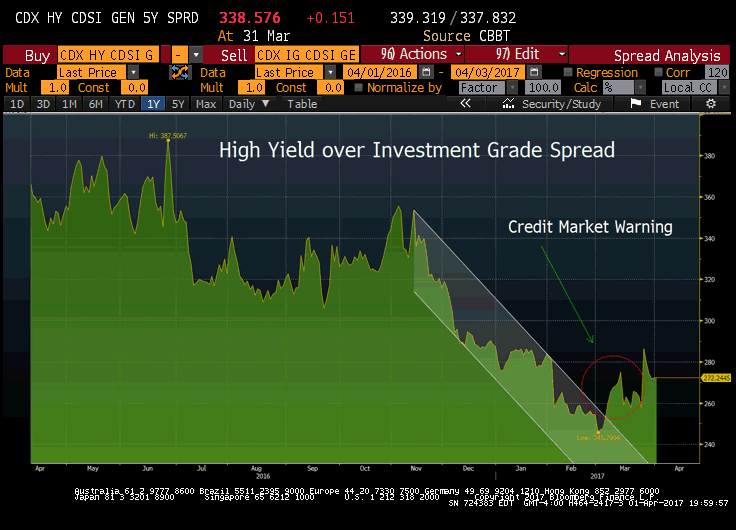Join our Larry McDonald on CNBC’s Trading Nation, Wednesday at 3:05pm ET
Pick up our latest note here:
Don’t miss our next trade idea. Get on the Bear Traps Report Today, click hereOne of the most reliable risk indicators in our 21 Lehman Systemic Index is the rate of change found in credit spread contagion.
If a fire is spreading quickly, it’s far more deadly. As we often share with clients, rule number one – credit leads equities. Since the financial crisis, nearly every significant drawdown in the stock market has witnessed meaningful (accelerated) credit deterioration in the weeks before. Our model measures this rate of change and quantifies its significance.
When compared to U.S. Treasuries – junk bond yield spreads have widened nearly 70 basis points since late February, reversing a long run of positive “risk on” spread compression. Looking back over the last seven years, the S&P 500 declined anywhere from 3.8% to 20.3% in the 11 plus examples of this contagion.
Looking back over the last 10 years, U.S. high yield finished Q1 in its 94 percentile in terms of expensiveness, now that’s rich.
CCC Love
Even worse, the junk of the junk smells like six day old fish but this month has a market embrace resembling a young bride holding on to fresh flowers.
Central Bank Induced Yield Chase, Created a Toxic Cocktail
If we Look at the CCC Rated Bond Universe
Annualized Returns
2008-2017: 16.8%
1996-2008: 1.4%
Bear Traps Report, Bloomberg data
CCC is a very speculative grade assigned to a debt obligation by a rating agency. Such a rating indicates default or considerable doubt that interest will be paid or principal repaid.
Moral Hazard in Energy Lending
Covenant standards in energy lending are at all time lows. The Bear Traps Report Team reviewed 15 oil and gas producers that have used 72%+ of their borrowing-base credit lines during spring redeterminations by lenders.
The Most Leveraged
Credit-line use exceeds 85% Abraxas Petroleum, Approach Resources, Mid-Con Energy Partners and Rex Energy.
Of course, crude oil price curves declining through 2021 may influence bank decisions on cutting credit lines.
Pick up our latest note here:
Don’t miss our next trade idea. Get on the Bear Traps Report Today, click hereHigh Yield vs. Investment Grade Bond Spread
 High yield has underperformed investment grade bonds by 25bps over the last 30 days.
High yield has underperformed investment grade bonds by 25bps over the last 30 days.
2017’s “Junk” Bond Prices
% of Bond’s Market Value
100-115: 73%
95-100: 15%
Below 95: 12%
Bloomberg TRACE, Citi Index data
It’s nothing short of crack smoking insanity. This month over 88% of high yield bonds were trading north of 95 cents on the dollar. Bloomberg / Bear Traps Report data.
High Yield Gross Leverage
2017: 4.6x
2016: 4.4x
2015: 4.2x
2014: 4.0x
2013: 3.7x
2012: 3.2x
2011: 3.9x
2010: 4.5x
2009: 4.4x
2008: 4.3x (Credit Crisis)
2007: 4.1x
2006: 3.6x
2005: 3.1x
2004: 4.1x
2003: 4.5x (Credit Crisis)
Bloomberg, Bear Traps Report Data, Capital IQ
We’re sorry, the high yield market is not on crack, it’s actually smoking crystal meth.
Total Leveraged Debt Outstanding*
2017: $2.5T
2007: $1.2T
1997: $310B
*subordinated bonds high yield, senior secured high yield bonds, senior unsecured bonds, first lien bank debt, second lien bank debt
Bloomberg, Barclays Credit Agg
Outflows
U.S. corporate high-yield funds posted $248.5m of outflows for the week ended March 29 after seeing an inflow of $736m last week, according to Lipper US Fund Flows data released this week.
Corporate investment grade funds saw inflows fall to $3.97b from $5.24b the week prior.
Investments in fixed-income exchange-traded funds declined 80 percent in the past week. Inflows to ETFs that invest in corporate bonds slowed and high-yield funds saw outflows.
Inflows to U.S.-listed bond ETFs totaled $1.14 billion in the week ended March 28, compared with $5.75 billion in the previous period, according to data compiled by Bloomberg.
Our Larry McDonald ran a $600m high yield and distressed credit business at Lehman Brothers, and is the NY Times bestselling author of a Colossal Failure of Common Sense.

Pick up our latest note here:
Don’t miss our next trade idea. Get on the Bear Traps Report Today, click here

